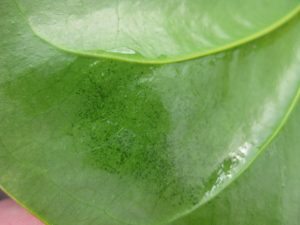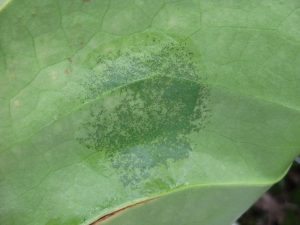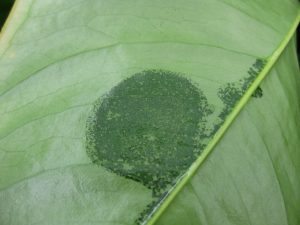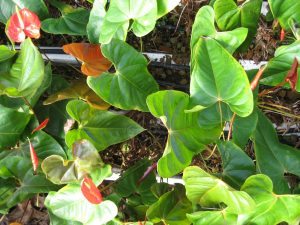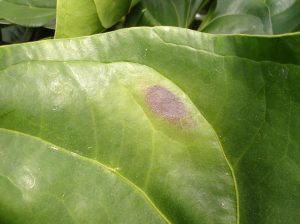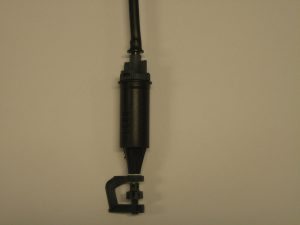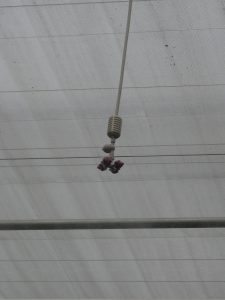Humidity is important to make photosynthesis possible. In the case of Anthurium, good humidity around the plant is even more important than for most other crops, because the plant can only absorb a reduced amount of humidity and hence has less water evaporation than most plants. If the plant loses too much water, the stomata will close with the result that photosynthesis stops. If this happens, no further CO2 can be absorbed, and CO2 is required to keep the photosynthesis going.
In addition, the temperature of a plant on a sunny day is mainly regulated by cooling through evaporation. Evaporating water can evacuate a lot of plant heat and is an efficient way of cooling for a plant. Open stomata ensure that a lot of heat can be evacuated. By closing the stomata, the plant temperature will often increase quickly.
Why is humidity so important and what are the options for keeping the stomata open?
Keeping the stomata open
In order to keep the stomata open, it is important to reduce the evaporation of the plant when there is more irradiation. By keeping the humidity in the greenhouse high, evaporation will be reduced. In addition, the greenhouse temperature can be lowered by introducing humidity, as a result of which the plant has to cool less through evaporation. Finally, the crop can be slightly moistened so that the evaporating water can cool the crop or the greenhouse temperature.
Keeping the stomata open is more important than the optimal amount of light In order to make photosynthesis possible, the stomata should be open to be able to absorb CO2. If you are able to keep the stomata open, photosynthesis will be possible with low light values. If the stomata are closed due to higher light values, no photosynthesis will take place. Of course, keeping the stomata open with the optimal light level delivers the maximum photosynthesis.
Are stomata open?
You can check whether the stomata are open or not with alcohol (>80%). Let some alcohol flow onto the underside of the leaf and rub it in; the alcohol will soak into the leaf through the open stomata. As a reaction, the leaf will turn dark green. The darker green the leaf turns, the more stomata are open. If there is no difference in colour after rubbing it in, the stomata are closed. This way, it is possible to determine to what extent the stomata are open.
Opening stomata from bad to good
Humidity in the greenhouse
With regard to humidity in the greenhouse, a distinction can be made between relative humidity deficit and microclimate.
The relative humidity deficit can be measured by the measuring boxes. The microclimate is the humidity between the plants from the substrate to the leaves. With the appropriate leaf coverage, the microclimate of the crop will be better. As the stomata are mainly found on the underside of the leaf, evaporation can be reduced with a good microclimate. This also applies when the humidity in the greenhouse is not that high. Of course, the microclimate is affected by the humidity in the greenhouse.
Worse microclimate due to open crop
Why is evaporation necessary?
Evaporation is the most important way for a plant to lose heat. Plants use on average approximately 5% of the light for photosynthesis. About 60% of the light that reaches the plant is converted into heat and should be evacuated by the plant chiefly through evaporation. Heating up water from 0 to 100⁰C (= 0.418 106J/kg) does not cost as much energy as letting water evaporate (2.26 106J/kg). Therefore, water evaporation by a plant is a very efficient way of evacuating heat.
The condition, however, is that the stomata stay open, otherwise it will be difficult for the plant to evacuate its heat. In this case, the plant temperature can increase too much, which may result in plant damage. An example of this is chlorophyll damage, as a result of which the leaf can turn yellow. The plant will substitute the chlorophyll where possible, which will cost it assimilates. If the plant temperatures increase further, parts of the plant can also be irreversibly damaged. This is visible in the burned parts of the leaf.
Burned leaf
Avoid the closure of stomata
In order to keep the stomata open, it is of course important to keep the humidity in the substrate at the right level and not to let the EC increase too much when the demand for water is high. In addition, by keeping a higher humidity percentage in the greenhouse, especially at more irradiation, too much humidity loss from the plant can be avoided. Where possible, this can be achieved by keeping humidity around the plant and, when the humidity diminishes, by working with air humidification. Stomata can also be kept open, where necessary, by limiting irradiation and/or by cooling the plants.
Measures for an optimal humidity regime
Keeping humidity in the greenhouse
With a good coverage of the plants, closing of screens and possibly foil, it is possible to keep more humidity in the greenhouse. Cutting back ventilation on the windward side and wind speed, for instance, can also achieve this. An important physical phenomenon is the fact that humid air has a higher energy content (enthalpy) than dry air. With higher humidity in the greenhouse, the same temperature drop can be achieved with a more limited window position as with dry air.
Use of crop or air humidification
Should the humidity in the greenhouse drop, it is possible to work with air humidification systems to increase the humidity and to lower the greenhouse temperature. There are, roughly speaking, two possibilities: crop and air humidification. With crop humidification, the crop is moistened, as a result of which direct cooling of the plant occurs, as the water on the plant evaporates. With air humidification, droplets are introduced as fine mist under pressure in the greenhouse. In order to allow the water mist to evaporate, energy is extracted from the atmosphere. This makes the temperature of the greenhouse air drop, making it moister.
There are four humidification systems:
1) Crop humidification by means of low pressure/droplet humidification;
2) Air humidification by means of low pressure/mist system;
3) Air humidification by means of high pressure/spray system (see Anthurinfo October 2008);
4) Pad and fan system: this system can be used in countries with high temperatures and lower air humidity. With this system, as well as humidifying the outside air, the greenhouse is also cooled.
From left to right: Low pressure droplet humifidication, low pressure air humifidication and high pressure air humifidication
Improving the microclimate
To improve the microclimate, you can keep extra humidity in the plants by providing good coverage. In addition, the microclimate can also be improved by watering. An irrigation pipe is the best option to moisten the top layer of the substrate than an irrigation tube. Especially for countries with a warmer climate, it is therefore necessary to have an irrigation pipe to improve the microclimate.
By moistening the top layer of the substrate, water from the substrate can evaporate better, which improves the microclimate. By irrigating more often with smaller quantities, the microclimate around the plant will be kept moister during the day. Abroad, the plants or the paths are sometimes watered by hand.
Irrigation pipe
Reducing irradiation
Should the humidity in the greenhouse after using all the available options still be too low, it is better to opt for reducing the irradiation. The heating of the plant is mainly reduced by minimizing irradiation. This can be achieved by providing extra screening or chalking the greenhouse deck. On days with a lot of irradiation, you can put up extra screens. In the middle of the day in particular, the amount of light can drop below the optimal value. If this keeps the stomata open, it will deliver a better yield in the end.
In summary
Keeping the stomata open for photosynthesis is extremely important. When the stomata are completely closed, no photosynthesis will be possible. When this process halts, the plant will not grow. By keeping the humidity in the greenhouse and around the plant at the right level, the plant will be able to keep its stomata open. Then CO2 can be absorbed and the plant temperature can be regulated through evaporation.
There are different ways to optimise humidity and microclimate.
– Keeping the greenhouse moist: appropriate leaf coverage, closing of screens/foil and less air on the windward side;
– Use of crop or air humidification;
– Improvement of the microclimate: irrigation pipes and watering;
– Lowering of irradiation to keep as many stomata as possible open. This makes it possible to further improve production and quality.
Keeping the stomata open for photosynthesis is extremely important. By keeping the humidity in the greenhouse and around the plant at the right level, the plant can keep its stomata open. Then CO2 can be absorbed and the plant temperature can be regulated through evaporation.
This article is part of the Anthurinfo May 2016. Read all articles here.
This article has been prepared with the cooperation of Bureau IMAC. Anthura and Bureau IMAC cannot be held responsible for any damages, whether direct or indirect, resulting from the use of the cultivation advice given.
Optional (depending on the article)
- The grower is at all times responsible for consulting the label of crop protection products.
- The cultivation information provided is geared towards Dutch growing locations.

